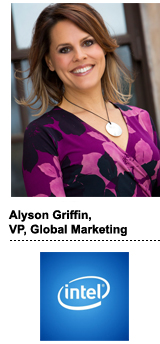For years, Intel’s five-note jingle was one of the most recognizable sounds on TV and helped build solid brand awareness for its consumer-facing PC business.
But a jingle isn’t going to encourage network administrators at a telco to embrace Intel’s open architecture or get senior decision-makers to consider Intel’s hybrid cloud platform.
“In the past, most of Intel’s outbound marketing was around big media buys and creating a big presence from a mass perspective,” said Alyson Griffin, VP of global marketing at Intel. “Now we’re building the infrastructure and pipes to do automated lead nurturing.”
Griffin is hiring a team of content writers and strategy folks to support Intel’s nascent B2B marketing efforts with a focus on content.
And it takes a lot of content to nurture and nudge committees of C-suite decision-makers down the funnel. The B2B sales cycle can often take the better part of a year or more and involves a committee of decision-makers tasked with vetting the options.
“We’re defining priorities for the business and growth opportunities across the board so that each initiative – data centers, network transformation, hybrid cloud – has a narrative assigned to it based on what the end customer needs,” Griffin said.
AdExchanger caught up with Griffin, who joined Intel in July after 17 years at HP, most recently as VP of marketing, to talk content creation, programmatic and why B2B decision-makers are just people at the end of the day.
 AdExchanger: Intel recently brought its programmatic media buying in-house. How does that impact the work you do?
AdExchanger: Intel recently brought its programmatic media buying in-house. How does that impact the work you do?
ALYSON GRIFFIN: Programmatic is in the mix. We partner very closely with [Intel global media director] Julie Keshmiry’s team on our strategy. We need to establish and create a brand for Intel around business transformation and then we need to show what that means.
Working together with the media side, we can say, “Here’s the story we’re telling this quarter or this half and these are the KPIs.” And then they can help us find the right media. We’re also working with our media partner, OMD, to do that, and with Resolution Media on the digital marketing side.
What is Intel’s B2B marketing strategy?
The goal is to build a brand for Intel within the business realm beyond PCs and consumers. We’ve done a lot of research on senior business decision-makers and found that they don’t know Intel outside of being a PC chip maker and they’re not aware we have a role to play in business transformation.
How are you putting that into practice?
We’re asking questions like: Where do network administrators or other personas live on the web? What do they like? And then we’re creating tailored assets like videos, white papers, ROI calculators – things that are beneficial to the business, not just spec sheets – so that we can target them rather than doing a generic media buy aimed at generic IT that drives people to our website from a banner ad.
We’re also thinking about content for different geos. For example, it doesn’t make sense to talk about health care in China the same way we talk about health care in the US. A lot of work is being done to make assets usable and informative to the culture where they’re going to land.
Intel launched a global B2B marketing campaign in April with your spokesman Jim Parsons and a new character called “The Future,” an anthropomorphic representation meant to demonstrate that cutting-edge technology like autonomous driving and AI is empowering rather than scary. How does that campaign fit into the overall B2B marketing strategy?
The campaign has three layers. The first layer is about reaching business leaders with TV spots, which is where Jim Parsons and The Future come in. We’re talking about business solutions for real pain points and business problems, but we’re doing it in a humorous way, which is different from most other B2B marketing assets.
Senior business decision-makers are people, too. They like to laugh, and when they come home at night, they’re just a consumer. The purpose of the spots is to get Intel’s name out there in a non-PC context.
The second layer is a vertical approach that goes into the Intel solution in a little more depth, like with health care, for example. We have a video that looks to the future when we’ll be able to map the human genome while someone waits in the doctor’s office. From there, decision-makers can access more content, case studies and the tools we’ve created for them.
In the third layer, having nurtured our prospects, we can talk about Intel’s product leadership and how to actually deploy the technology, which is more in Intel’s historical comfort zone.
Considering the length of the B2B customer journey, what are your KPIs here?
The main KPI is benchmarking whether we’re known for something more than being a PC chip maker, to see if we become known for business transformation. Initially we’re focused more on awareness and consideration than preference and purchase because we’re newer to this game.















